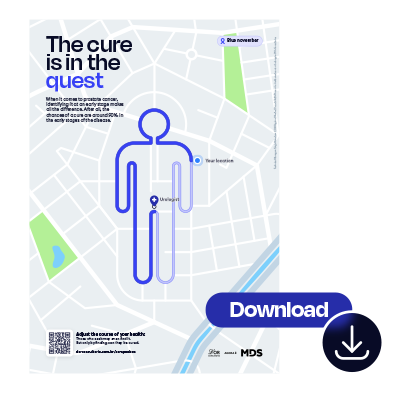
Statistics like these should be enough to encourage men to find out more about the disease and anticipate it. But that’s not what actually happens:
Do you know what the chances of a cure are if you discover the disease in its early stages?
Memory game
Blue November
Search without fear and in a didactic way
Click and play after reading the full content of this page!


If you think that excuses such as lack of time will guarantee your health, recalculate your route!
amily, work and other responsibilities will always exist. In fact, they will only exist if, before they do, you are up to date with your commitment to your health.
A survey by the São Paulo Reference Center for Men’s Health shows that 70% of men who visit a doctor’s office have been influenced by their wives or children.
The study also reveals that more than half of these patients postponed going to the doctor and arrived with diseases at an advanced stage.

As a consequence of this and other behaviors, such as greater risk-taking behavior, men live less than women in every country in the world. And in Brazil, the difference is of almost 7 years:
79,9 years
72,8 years
Is the path to early detection complicated?
Quite the opposite! And all you need to do is set aside a single day of your year for the exam. Which could be:
PSA Test
This is the test used as screening to diagnose prostate cancer in men before they even have any symptoms.
It is carried out by simply taking a venous blood sample, which measures the amount of a protein produced by the prostate, the Prostate-Specific Antigen. Hence the “PSA”.
Digital Rectal Exam (DRE)
Also indicated for examining problems in the anus and rectum, such as hemorrhoids, rectal examination is very effective at identifying changes that could be a sign of prostate cancer.
The procedure only lasts about 10 seconds, it doesn’t hurt, it doesn’t pose any health risks, let alone any manhood risks.
You have successfully reached your destination!
The urologist plays a crucial role, not only in the treatment of prostate cancer, but also in the early diagnosis of this cancer and other urological diseases. And it should be visited frequently by men.
Pay extra attention
if you…
…are or know someone aged 45* or over:
This is the right age to visit the urologist every year and keep your exams up to date. Remember that when the disease is detected early, the chances of a cure are huge.
…are or know a transgender woman, transvestite or non-binary person:
The exam cannot be skipped in these cases, even for those who have already undergone gender reassignment surgery.
This is because there are still not many studies on the theory that the use of estrogen and the removal of the testicles reduce the risk of prostate cancer.
What’s more, when cancer develops even when testosterone is low, it tends to be more aggressive.
*Recommended age for patients with a family history of prostate cancer, morbid obesity, and/or Black individuals.
For all other cases, the age range is 50.
Get to know the guidelines of the Brazilian Society of Urology.
What are the
risk factors?




Are there any shortcuts to preventing prostate cancer?

Unfortunately, cancer cannot be prevented. However, it is possible to reduce the chances of it occurring (and thousands of other diseases as well) through healthier habits.
Adopt a more balanced diet, avoiding ultra-processed options for example, and include regular physical activity in your routine.
Are there any shortcuts to identifying the symptoms of the disease?
Some symptoms require attention:
If you notice any of these symptoms, seek medical attention immediately.
Support this campaign
Download the poster and wallpaper to spread the word to everyone you know.

Adjust the course of your health:



